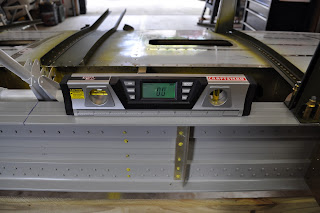Hey, this is a blog site so I am going to rant on building a little bit.
First, it is a big decision to build just a bout anything. A house, car, boat, whatever. It starts with the first steps. Dreaming, investigating, brochures, and planning. Lot's of it. Building an airplane is no different.
I've had the aviation bug going back to my earliest memories. My mom nourished those thoughts by giving me aviation books and models. (Still have the books.) My dad was in the Army Air Corp during WWII. He was an armament specialist on P-47 Thunderbolts. Thanks Mom & Dad for everything!
My first General Aviation (GA) plane I bought was in one of those same books my mom got me in the 60's and early 70's. (How to Buy a Plane.) It took me until 2002 to really answer my call to aviation. I received my private pilots certificate on December 8, 2003, just before the 100th Anniversary of flight.
I purchased the flap kit for the Mustang II from Mustang Aeronautics in March of 2010. It was delivered in early April and I went on to complete it in June 2010.
There are quite a few things I learned about building from the flap assembly. Building will be hard at times. Building can be tedious. The smallest parts & tasks can (and usually do) take the longest to complete. But, on the other hand, building can and is rewarding and most importantly I can do this. I can do this! AND, so can you.
I have acquired some of the necessary skills needed to build a plane just by completing the flap kit. I also called Chris, at Mustang Aero with questions. (Chris is a wealth of information on the plane.) I joined the on line builders group, mustangaero, on Yahoo. I have been an EAA member since 2001 and have been a member of a local EAA chapter since 2010. (Not to mention all the building airplanes books and literature I have accumulated over the last couple of decades.)
All of that in the above paragraph helps to keep me on a track to complete my airplane. Everybody or group mentioned wants you to complete your dream. Some of those individuals will go out of their way to see that you are progressing to completion. This network of people is a great resource.
If you decide to build you will need your family's understanding and support. Without it you will not be able to complete the project or enjoy what you are doing. (You need some understanding also. You have to make time for the family , too.)
In October of last year I ordered the remainder of the plane. I received the plans and building instructions right away. I picked the plane up from Troy, Michigan, home of Mustang Aeronautics, on March 29, 2011. I started building right out of the box.
I found at times it was hard to find time to build. All kinds of other stuff just kept getting in the way. (Life)
If I get away from the project for a few days it takes me a day or two to get back in the swing or to find where I left off. So, plan, investigate, trim and fit, drill and debur, put together, take apart, try again.........and finally you get to a point where you feel you have accomplished something.
Maybe you achieve one of the small goals or a milestone in the building process that makes you feel like you have accomplished a major goal in your building timeline that really makes you feel you are going to build and fly this airplane in your lifetime!
With the help of several friends over the last weekend I feel I have crossed a point in the building of my plane that has made me feel very good and I have to say thank you for all of your help! Without it I would not be as far along as I am.
There you go! The wing center section is complete and on a new assembly fixture. I will now start assembly of the forward fuselage and back to the empennage. My next goal is to have the airplane on the "gear" by the summer of 2012.
It will happen as long as I keep trying to do a little each day. Planing & dreaming!
Later,
Brian
 I finally leveled the CS wing in the fixture. Looking pretty good. Now I have the next phase of the build ahead. Constructing the forward fuselage. I clamped the upper fuselage stringers in place and removed the CS leading edges.
I finally leveled the CS wing in the fixture. Looking pretty good. Now I have the next phase of the build ahead. Constructing the forward fuselage. I clamped the upper fuselage stringers in place and removed the CS leading edges.














